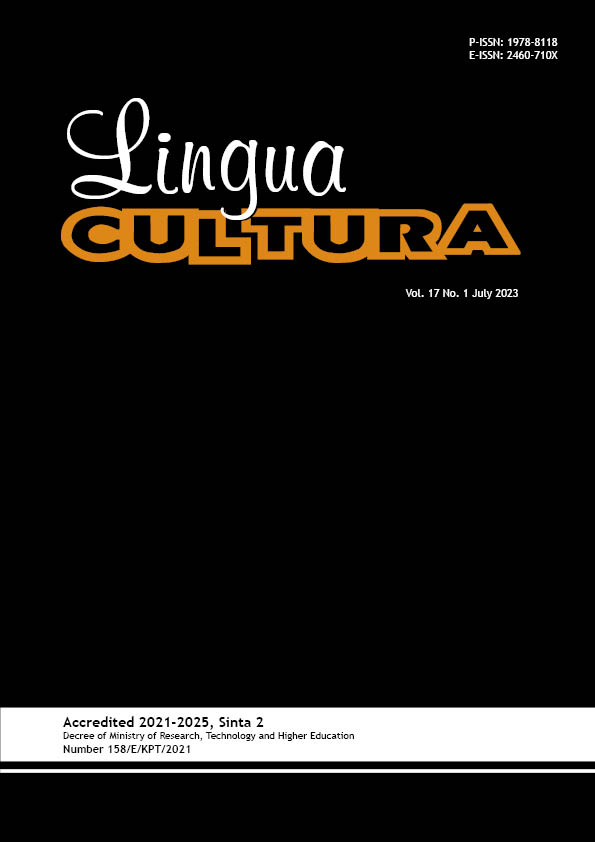Jiro Dreams of Sushi: A Circuit of Shokunin
DOI:
https://doi.org/10.21512/lc.v17i1.8444Keywords:
shokunin, production, consumption, film studies, cultural studiesAbstract
The research looked at David Gelb’s 2011 documentary, Jiro Dreams of Sushi, from the shokunin concept’s perspective. Referring to Hall’s circuit of culture, the research focused on two interrelated links within cultural studies: production and consumption. Production and consumption referred to the sushi culture. Shokunin was defined as mastery of one’s profession or artisans. The film reflected this concept through the character, Jiro Ono, who dedicated his life to excelling in making sushi. The method applied in the research was qualitative. The data were drawn from the film’s cinematography which referred to the camerawork, and mise-en-scène, which referred to everything on the film frame, as part of the film studies method applied. The findings show that in terms of production and consumption of sushi within the circuit of culture, the film has shown the interrelated meaning of sushi culture: that in the context of Jiro Ono’s sushi, sushi becomes more than just food, but through its complex production and consumption process, sushi culture becomes a representation of ancient Japanese concept, shokunin, which emphasizes on discipline, perfection, beauty and of course, hard work, and sacrifice. These findings are supported by visualizing the production and consumption through the film’s cinematography and mise-en-scène.
References
Andriyani, N., & Hidayat, Z. (2021). The influence factors on customer satisfaction and loyalty in distribution: An empirical study on Sushi Tei restaurant, Jakarta. Journal of Distribution Science, 19(6), 51-64. https://doi.org/http://dx.doi.org/10.15722/ jds.19.6.202106.51.
Ang, I. (2020). On cultural studies, again. International Journal of Cultural Studies, 23(3), 285-291. https://doi.org/DOI: 10.1177/1367877919891732.
Arvind, P. (2019). Stuart Hall’s circuit of culture- media culture- with reference to film. IOSR Journal of Humanities And Social Science, 24(4), 38-40.
Baumert, N., & Fukuda, I. (2021). The raw and the cooked in Japanese cuisine: Triangulations around culture, nature and artifice. Antrophology of Food, 15, 1-19. https://doi.org/https://doi.org/10.4000/aof.12807.
Clark, T. (2017). Who would eat such a fish? Sage Journals, 16(3), 26-33. https://doi.org/https://doi.org/10.1177/1536504217732049.
Dempsey, D. (2015). Shokunin-do, the way of the shokunin: The intersection of art, philosophy and a life well-lived: Edo period Japan, 19th-century France, and today. USA: Tufts University. Retrived from https://dl.tufts.edu/pdfviewer/f4752t98t/0z7097603.
Dordevic, D., & Buchtova, H. (2020). Nutritional profile of nigiri sushi meal and the usage of citrate synthase activity as freshness parameter. Iranian Journal of Fisheries Sciences, 19(6), 2954-2969. https://doi.org/10.22092/ijfs.2020.122924.
Eskild, P., & Aarhus, D. (2019). ‘Tingling throat syndrome’ as asymptomatic anisakiasis following conveyor belt sushi consumption in Tokyo. International Journal of Infectious Diseases, 82, 102-103. https://doi.org/10.1016/j.ijid.2019.03.019 1201-9712.
Gelb, D. (2011). Jiro dreams of sushi. New York: Magnolia Pictures.
Holt, R., & Yamauchi, Y. (2019). Craft, design and nostalgia in modern Japan: The case of sushi. In E. Bell, G. Mangia, S.
Taylor, & M. L. Toraldo (Eds.), The Organization of Craft Work: Identities, Meanings, and Materiality. New York: Routledge.
Kiatkawsin, K., & Sutherland, I. (2020). Examining luxury restaurant dining experience towards sustainable reputation of the Michelin restaurant guide. Sustainability, 12(5), 2134. https://doi.org/10.3390/su12052134.
Kulawik, P., & Dordevic, D. (2020). Sushi processing: Microbiological hazards and the use of emerging technologies. Critical Reviews in Food Science and Nutrition, 62(5), 1270-1283. https://doi.org/10.1080/10408398.2020.1840332.
Lankhuizen, T., Savardi, M., Balint, K., & Konijn, E. A. (2020). Shaping film: A quantitative formal analysis of contemporary empathyeliciting Hollywood cinema. Psychology of Aesthetics, Creativity, and the Arts, 16(4), 704-718. https://doi.org/10.1037/aca0000356.
Leer, J. (2022). Gender and barbecue: The gendering of tradition, innovation and space in the Netflix series Chef’s Table: BBQ (2020). Antrophology of Food, 16, 1-16. https://doi.org/10.4000/aof.12915.
Nakayama, M., & Wan, Y. (2019). Same sushi, different impressions: A cross-cultural analysis of Yelp reviews. Information Technology & Tourism, 21, 181-207. https://doi.org/10.1007/s40558-018-0136-5.
Neus, G., Eudald, C., Isa, M., Antonio, M., Rasmur, la C., Jens, J. S., Marti, N., Montse, M., & Jose, L. D. (2021). Dietary exposure to potentially toxic elements through sushi consumption in Catalonia, Spain. Food and Chemical Toxicology, 153, 112285. https://doi.org/https://doi.org/10.1016/j.fct.2021.112285.
Maurice, G. S (2018). Sensing bodies at the the center in today’s traditional Japanese restaurant kitchens. Japanese Studies, 38(1), 1–20. https://doi.org/https://doi.org/10.1080/10371397.2018.1465803
Downloads
Published
How to Cite
Issue
Section
License
Copyright (c) 2023 Anton Sutandio

This work is licensed under a Creative Commons Attribution-ShareAlike 4.0 International License.
Authors who publish with this journal agree to the following terms:
a. Authors retain copyright and grant the journal right of first publication with the work simultaneously licensed under a Creative Commons Attribution License - Share Alike that allows others to share the work with an acknowledgment of the work's authorship and initial publication in this journal.
b. Authors are able to enter into separate, additional contractual arrangements for the non-exclusive distribution of the journal's published version of the work (e.g., post it to an institutional repository or publish it in a book), with an acknowledgment of its initial publication in this journal.
c. Authors are permitted and encouraged to post their work online (e.g., in institutional repositories or on their website) prior to and during the submission process, as it can lead to productive exchanges, as well as earlier and greater citation of published work.
USER RIGHTS
All articles published Open Access will be immediately and permanently free for everyone to read and download. We are continuously working with our author communities to select the best choice of license options, currently being defined for this journal as follows: Creative Commons Attribution-Share Alike (CC BY-SA)


















